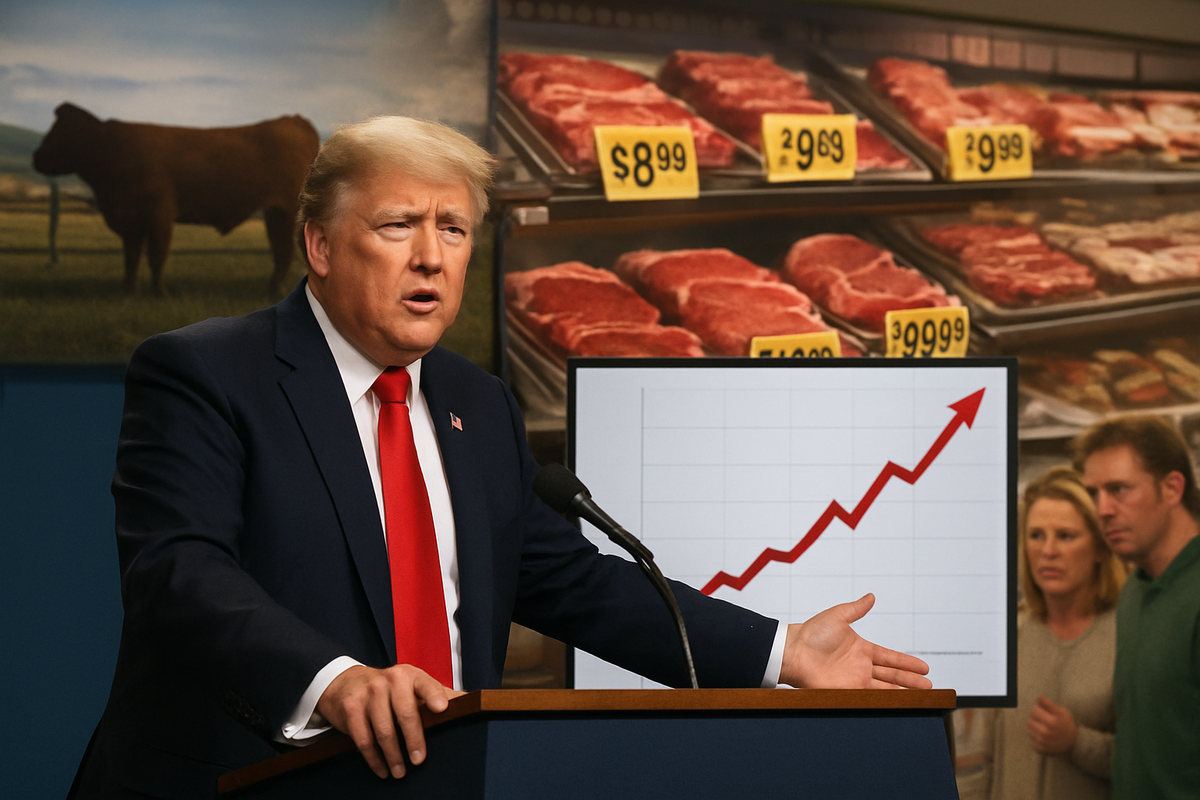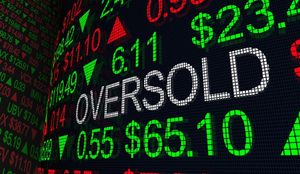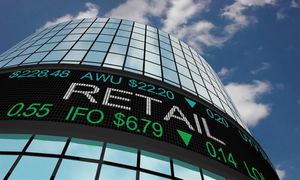
Washington D.C., November 25, 2025 – As American consumers grapple with persistently high beef prices, former President Donald Trump has escalated his rhetoric, publicly accusing foreign-owned meatpacking companies of "Illicit Collusion, Price Fixing, and Price Manipulation." His calls for an immediate Department of Justice (DOJ) investigation signal a potential new front in government scrutiny of the food supply chain, even as robust consumer demand for beef continues to defy economic headwinds. This development places the spotlight squarely on the complex interplay of supply shortages, global trade, and political intervention in the nation's meat markets.
The accusations arrive amidst a period where U.S. beef prices have reached unprecedented levels, with ground beef hitting an all-time high of $6.32 per pound and uncooked steaks soaring to $12.62 per pound in September 2025 – significant year-over-year increases. Despite these elevated costs, American households have maintained a strong appetite for beef, with fresh beef retail sales surpassing $40 billion in 2024 and per capita consumption reaching its highest point since 2009. This paradoxical situation of record prices met with sustained demand underscores the deep-seated market forces and consumer preferences at play, now further complicated by high-level political intervention.
Unpacking the Allegations and Policy Shifts
Trump's recent focus on beef prices has manifested in several key actions and statements leading up to and around November 2025. His direct accusation of "Illicit Collusion, Price Fixing, and Price Manipulation" by foreign-owned meatpacking companies, while lacking immediate public evidence, has set the stage for potential federal inquiries. This move aligns with his broader economic agenda to "make America affordable again," consistently vowing to lower overall food and grocery prices.
Earlier in October 2025, the Trump administration signaled intentions to significantly increase Argentinian beef imports as a strategy to alleviate domestic prices. This proposal, however, met swift and strong opposition from U.S. cattle ranchers and Republican lawmakers, with organizations like the National Cattlemen's Beef Association (NCBA) expressing concerns that such a policy would undermine American producers. Further impacting global trade, around November 24, 2025, Trump moved to remove 40% tariffs on Brazilian food products, including beef. This decision had an immediate, albeit gradual, effect on live cattle and feeder cattle futures, causing them to fall. Experts caution that any resulting price reductions for consumers would likely be slow to materialize due to logistical challenges and the time it takes for savings to be passed down the supply chain.
Adding to the administration's strategic efforts, Agriculture Secretary Brooke Rollins unveiled a comprehensive plan in October 2025 aimed at strengthening the American beef industry. This strategy encompassed deregulatory reforms, initiatives to boost domestic processing capacity—such as integrating more locally raised beef into school programs—expanding grazing access, and addressing longstanding regulatory obstacles for ranchers. The overarching goal was to ensure an affordable protein supply for American consumers while fostering a robust economic environment for ranchers. These policy shifts and accusations have injected a new layer of volatility into the beef markets, with futures reacting promptly to political directives.
Corporate Crossroads: Winners, Losers, and Market Reactions
The recent developments are poised to significantly impact major players within the beef industry, creating potential winners and losers. Large meatpacking corporations such as Tyson Foods (NYSE: TSN), a key American processor, and JBS S.A. (B3: JBSS3), a Brazilian-owned global giant with substantial U.S. operations, will be under intense scrutiny. Trump's accusations of price fixing and collusion, if pursued by the DOJ, could lead to costly legal battles, fines, and reputational damage for these companies, potentially affecting their stock performance and investor confidence. Increased imports from Argentina and Brazil, facilitated by tariff removals, could also introduce greater competition, potentially squeezing profit margins for domestic processors if they cannot adapt to lower input costs or face increased supply.
Conversely, American cattle ranchers, represented by groups like the NCBA, initially expressed concern over increased imports, fearing it would depress domestic cattle prices and further challenge their already strained operations. However, the administration's broader strategy, outlined by Agriculture Secretary Rollins, aims to bolster the American beef industry through deregulatory reforms and increased processing capacity. These measures could offer a long-term benefit to ranchers by improving efficiency and market access, potentially offsetting some of the short-term pressures from increased imports. Consumers, in theory, stand to gain from lower prices if the increased supply and competitive pressures are effectively passed down. However, the benefits are expected to be gradual, and the immediate impact on household budgets remains uncertain.
The market's initial reaction to the removal of Brazilian food tariffs saw live cattle and feeder cattle futures decline, indicating a perception of increased supply and potential downward pressure on prices for raw materials. This could benefit meatpackers in the long run by reducing their input costs, assuming they can maintain or grow demand. However, the political rhetoric and potential for regulatory intervention introduce significant uncertainty, which often leads to market volatility and could deter investment in the sector until clearer outcomes emerge from the investigations and policy implementations.
Broader Significance and Industry Undercurrents
Trump's intervention in the beef market transcends mere price concerns; it highlights a confluence of broader industry trends and policy implications. A primary driver of the record-high beef prices is the U.S. cattle supply, which is currently at its lowest level in decades, a situation exacerbated by prolonged drought conditions and years of unfavorable market prices for ranchers. The USDA forecasts a 4% decrease in U.S. beef production in 2025 compared to 2024, with a multi-year recovery period anticipated. This domestic supply deficit has, in turn, fueled a significant increase in U.S. beef import demand, projected to reach a record high of over 2 million tons in 2025.
The regulatory and policy implications are substantial. A DOJ investigation into alleged price fixing would echo past anti-trust concerns raised in the meatpacking industry, potentially leading to stricter oversight or even structural changes if wrongdoing is found. Government intervention in food prices, whether through tariff adjustments or calls for investigations, sets a precedent for how future administrations might address inflation in essential goods. Historically, governments have occasionally intervened in food markets during periods of high inflation or supply shortages, often with mixed results regarding long-term price stability and market efficiency. The current situation fits into a broader pattern of global food inflation, although beef prices have outpaced general grocery inflation, which had stabilized between 1-2% since January 2024.
Furthermore, these events underscore the increasing globalization of the food supply chain. Decisions regarding tariffs and import volumes, particularly from major beef-producing nations like Argentina and Brazil, have direct and immediate impacts on domestic markets. The delicate balance between supporting domestic producers and ensuring affordable consumer prices through international trade remains a significant policy challenge. The ongoing debate also highlights the consolidation within the meatpacking industry, which has long been a point of contention for ranchers and consumer advocates alike, who argue that it gives a few large companies undue market power.
What Comes Next: Navigating a Volatile Landscape
The immediate future of the beef market is likely to be characterized by continued volatility and intense scrutiny. In the short term, the DOJ investigation into alleged price fixing will be a critical watchpoint. Any concrete findings or lack thereof will significantly influence public perception, regulatory actions, and potentially the operational strategies of major meatpackers. Consumers should anticipate that any price reductions resulting from increased imports or tariff removals will be gradual, as logistical hurdles and the time required for distributors to pass on savings will delay the impact.
Looking further ahead, the long-term trajectory of beef prices hinges largely on the rebuilding of the U.S. cattle herd, a process that experts estimate will take several years. While some industry experts predict ground beef prices could reach $10 per pound by late 2026, others remain skeptical, suggesting that a broader decrease in beef prices may not occur until late 2027. This prolonged period of high prices could eventually lead to shifts in consumer behavior, with some economists warning of a potential weakening of demand if economic uncertainties persist. Strategic pivots may be required from both producers and retailers, focusing on efficiency, alternative protein sources, or adapting to changing consumer purchasing habits, such as increased demand for store brands or more creative use of leftovers.
Market opportunities may emerge for companies that can efficiently manage global supply chains, innovate in processing to reduce costs, or offer more competitively priced beef products. Conversely, challenges will persist for smaller ranchers and processors who struggle with scale and market access. Potential scenarios range from a successful government intervention leading to more competitive pricing and a healthier domestic industry, to a prolonged period of high prices, continued reliance on imports, and persistent consumer frustration. Investors will need to closely monitor policy shifts, consumer spending trends, cattle inventory reports, and the outcomes of trade negotiations to navigate this evolving landscape.
A Market in Flux: Key Takeaways and Investor Watchpoints
The current situation in the U.S. beef market is a microcosm of broader economic and political forces at play. Donald Trump's direct intervention, accusing foreign-owned meatpackers of collusion, underscores a renewed political focus on food inflation and the structure of critical industries. This political pressure, combined with a decades-low domestic cattle supply and robust, albeit adapting, consumer demand, creates a complex and volatile environment. The removal of tariffs on Brazilian beef and plans for increased Argentinian imports reflect a strategy to boost supply, but the immediate benefits to consumers are expected to be slow, and domestic producers face new competitive pressures.
Moving forward, the market will be shaped by the ongoing DOJ investigation, the pace of the U.S. cattle herd rebuilding, and the effectiveness of the Trump administration's broader agricultural policies. For public companies like Tyson Foods (NYSE: TSN) and JBS S.A. (B3: JBSS3), navigating accusations of price fixing and increased import competition will be paramount. Their ability to demonstrate fair practices and adapt to changing supply dynamics will be crucial for their financial performance and reputation.
Investors should closely watch for developments in the DOJ inquiry, which could have significant legal and financial implications for major meatpackers. Additionally, monitoring consumer spending patterns, especially any signs of sustained demand weakening due to high prices, will be critical. Updates on U.S. cattle inventory reports will provide insights into the long-term supply outlook, while shifts in global trade agreements and tariff policies will continue to influence import volumes and domestic market competition. The beef market is at a pivotal juncture, where political will, economic realities, and consumer resilience will collectively determine its path in the coming months and years.
This content is intended for informational purposes only and is not financial advice





